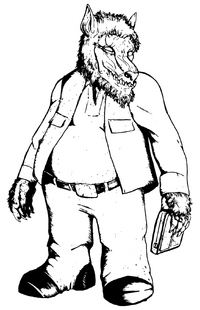The Needan system was located in Wild Space and contained the planet Needan, the homeworld of the sentient Geelan species. At one point, a passing comet impacted the planet, causing its climate to become cold to the point of extinction of the majority of its species. After the Geelans subsequently sent distress signals into outer space, an Arcona medical starship arrived at Needan and established first contact with the natives, leading to a dispersal of the Geelan into the wider galaxy.
Description[]
The Needan system[1] was a dying star system[3] situated in Wild Space.[1] It contained a single star that was orbited by the life-rich terrestrial[2] planet[4] Needan, the homeworld of the sentient Geelan species. At one point, the system also contained a passing comet.[2]
History[]

The Geelan species was native to the Needan system's planet of the same name.
At one point, a passing comet impacted Needan. The collision sent the planet into a wider orbit[5] on a trajectory rapidly carrying it away from its sun. The consequent, rapid onset of permanently cold and winter-like climate on Needan led to the extinction of the majority of the planet's species.[2]
Geelan scientists eventually began sending out distress signals into outer space.[2] At some point by the time of the Galactic Civil War,[3] the signals were intercepted by a medical starship crewed by members of the Arcona species, who tracked and followed the communication, leading them to Needan. As a result of the following offworlder visit, the Geelan learned of and adapted galactic technology. The fact that their homeworld was dying led many Geelan to emigrate and explore the wider galaxy.[2]
Behind the scenes[]
The Needan system was first indirectly mentioned in "Zirtran's Anchor," a roleplaying game article written by Anthony P. Russo and published in the February 1995 fifth issue of West End Games' Star Wars Adventure Journal magazine.[3] The 2009 reference book The Essential Atlas by Daniel Wallace and Jason Fry named the system and placed it in grid square I-20.[1]
Sources[]
 "Zirtran's Anchor" — Star Wars Adventure Journal 5 (First mentioned) (Indirect mention only)
"Zirtran's Anchor" — Star Wars Adventure Journal 5 (First mentioned) (Indirect mention only)- The Essential Atlas (First identified as Needan system)
 Star Wars: The Essential Atlas Online Companion on StarWars.com (article) (backup link)
Star Wars: The Essential Atlas Online Companion on StarWars.com (article) (backup link)
Notes and references[]
- ↑ 1.0 1.1 1.2 1.3 1.4 The Essential Atlas
- ↑ 2.0 2.1 2.2 2.3 2.4 2.5 2.6 2.7 2.8 Alien Encounters
- ↑ 3.0 3.1 3.2
 "Zirtran's Anchor" — Star Wars Adventure Journal 5
"Zirtran's Anchor" — Star Wars Adventure Journal 5
- ↑
 "Alien Encounters" — Star Wars Adventure Journal 13
"Alien Encounters" — Star Wars Adventure Journal 13
- ↑ The Complete Star Wars Encyclopedia, Vol. I, p. 329 ("Geelan")
